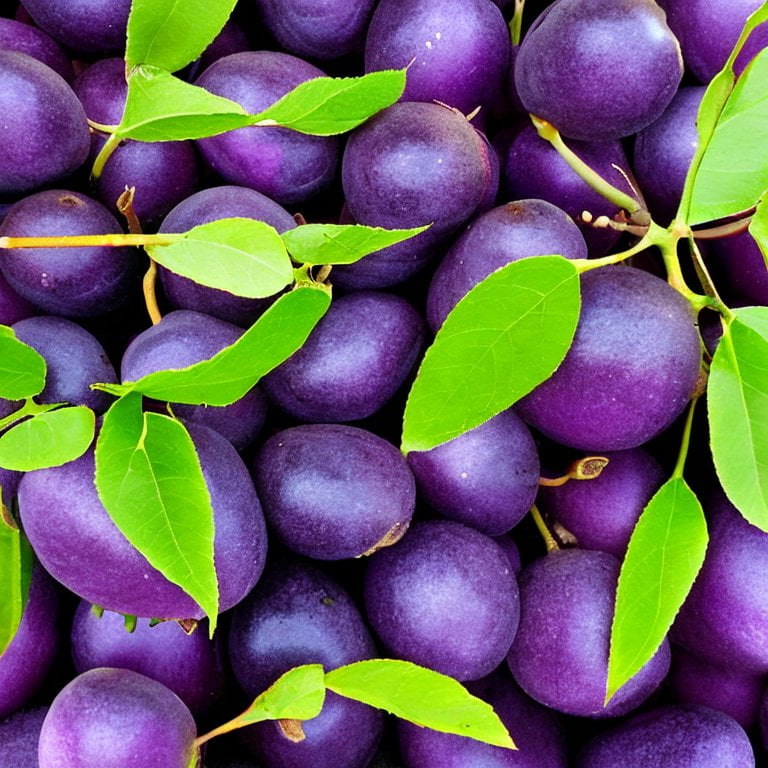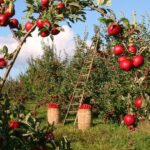
The Damson is a type of plum, that grows in many parts of the world. It has a blue, purple colored skin and a small oval shape, found growing on the Damson tree. But can Damsons be eaten? In this post, we will answer that, as well as some common uses.
Table of Contents
- What are Damsons?
- Where Do Damsons Grow?
- Can You Eat Damsons?
- How Do You Eat Damsons?
- Final Thoughts
What are Damsons?
The damson, a type of plum belonging to the Prunus genus, shares ancestry with cherries, peaches, and plums. Its roots trace back to Western Asia and Europe, where for thousands of years, people have savored its juicy, flavorful fruit. (See What are Blue Damsons?)

This small to medium-sized tree, reaching up to 20 feet, boasts oval-shaped, dark green leaves and fragrant white or pink blooms in spring. Damsons are hardy and adaptable, able to endure cold and thrive in various soil types, although they prefer well-drained soil with a pH of 6.0 to 7.0 and require full sun exposure. Winter cold is crucial for these trees to produce fruit in summer.
Where Do Damsons Grow?
The Damson, a species of plum, thrives in many parts of the world – from Europe to Asia, and North America. England, France, and Germany have been nurturing Damson trees for generations, making it a common sight. Meanwhile, in Asia, it flourishes in China, Japan, and Kazakhstan.
North America, with its temperate climate, is also home to the Damson, found in areas like California, Washington, and Oregon. This fruit-bearing tree demands warmth and adequate rainfall to grow, making temperate regions the perfect place for its cultivation.
Can You Eat Damsons?
Absolutely, damsons are edible and you can eat them. These plums, known for their small size and tart taste, are a staple in the kitchen. They are used to create jams, jellies, and other preserves and add a burst of flavor to cakes, pies, sauces, and other dishes. (See Damson Recipes)
How Do You Eat Damsons?
When consuming damsons raw, it’s best to opt for ripe and firm fruit without bruises or imperfections. They can be eaten alone as a snack or added to salads. Additionally, they make a delightful topping for oatmeal, yogurt, and ice cream. The tangy taste of the damson perfectly complements the sweetness of these foods. (You can also stew damsons before eating them. See Stewed Damsons)
Damsons can also be cooked in many ways to bring out their rich, fruity flavor. A popular method is to simmer them in sugar and water, creating a delicious compote that can be served as a dessert or used as a topping for pancakes, waffles, or breakfast items. (See Damson Compote)
They can also be baked into pies, crumbles, and other baked goods. The tartness of the damson pairs perfectly with spices such as cinnamon, nutmeg, and cloves, which can enhance the flavor of the dish. (See Damson Crumble)
Making preserves or jams with damsons requires ripe and flavorful fruit. The fruit naturally contains pectin, which thickens the preserve or jam, eliminating the need for added pectin. Simply simmer the damsons in sugar and water until the fruit is soft and the liquid has thickened, then pour the mixture into sterilized jars and store in either the refrigerator or pantry. (See Damson Jam Recipe as well as all of the Damson Jam Recipes)
Damsons are also used to create wine and liqueur. The fruit can be fermented with sugar and yeast to create a sweet and fruity wine or distilled with alcohol to produce a liqueur. Both of these beverages are popular in Europe, where damsons are widely grown and used in various dishes and drinks. (See Damson Plum Liqueur Recipe)
You can also stew the damsons
Final Thoughts
Damsons are a versatile and flavorful fruit that can be enjoyed in a variety of ways. Whether raw, cooked, or as a preserve or beverage, there is no shortage of delicious and healthy options to experience the unique taste of this fruit. So, the next time you’re seeking a healthy and delicious snack or ingredient, reach for some damsons and let your culinary creativity soar!
Lance has been passionate about the plant-based diet and we have been following a whole food plant-based diet for over 5 years. We focus on health, natural healing, weight management, animal rights, and the health of the planet and environment by focusing on whole plant-based foods and sustainable practices.
Learn more at the About Me page and follow on social media at the links below.






